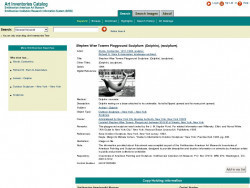Jean-Marie Galing's collections
Playgrounds
<p>Images support learning in primary grade paper sculpture lessons.</p>
 Jean-Marie Galing
Jean-Marie Galing
9
Animal Masks
<p>Allow small groups to "see/think/wonder" about a mask image: Look and describe what you see. Based on what you see, what do you think the mask is for? What do you wonder about the mask (or want to learn about the mask)? Then allow students to click the Information button to learn more. Groups can report out to the whole class.</p>
<p>Facilitate a discussion with students using some open ended questions:</p>
<ul><li>Why do people make and wear masks? </li><li>What can be hidden or revealed using a mask?</li><li>What might a mask symbolize or stand for?</li><li>If you were to design a mask for a special purpose, what would it look like? </li></ul><p>Direct students to sketch their ideas to plan for creating a mask. </p>
<p><br /></p>
<p><br /></p>
 Jean-Marie Galing
Jean-Marie Galing
10
A Special Place - Woodcut & Linocut Prints
<p>View selected prints of different places, then discuss: </p>
<p></p>
<ul><li>What is the first thing you notice?</li><li>What do you believe is special about this place?</li><li>How did the artist use composition to highlight what is special?</li></ul><p>Choose one print to examine:</p>
<p></p>
<ul><li>What kinds of lines, patterns or textures did the artist use?</li><li>How did the artist use tools to create areas of light and dark?</li></ul><p>Apply in your own work:</p><p><br /></p><p></p>
<ul><li>What makes a place special or meaningful to you?</li><li>What clues will help capture the uniqueness of your special place?</li></ul><p>ARTMAKING CHALLENGES:</p><ul><li>Draw a picture of a special place using foreground, middle ground, and background. Use a variety of lines and cross hatching to create texture and value.</li><li>Sketch your special place, then transfer the design to a soft rubber printing plate. Using a lino cutter, outline the major areas and cut away areas that will remain light. Use a variety of lines and cross hatching to create areas of light and dark in the prints. Ink your printing plate and pull several prints. </li><li>Create a painting of a special place using foreground, middle ground, and background. Mix tints and shades. Use color to communicate an emotion linked to your special place. </li></ul><p></p>
<p></p>
<p></p>
 Jean-Marie Galing
Jean-Marie Galing
14
Mystery and Fantasy
<p>These artworks are <strong>enigmatic</strong> - "mysterious, puzzling, hard to understand, mystifying, inexplicable, baffling, perplexing, bewildering, confusing, impenetrable, inscrutable, incomprehensible, unexplainable, unfathomable, indecipherable." They are open to interpretation. </p><p>Look at one or more of these artworks. How did the artist create a sense of mystery or fantasy? What do you think it could mean? </p>
 Jean-Marie Galing
Jean-Marie Galing
16
Posters, Pins & Postage for a Cause
<p>Analyze selected images and discuss:</p>
<p></p>
<ul><li>What is the cause or social issue?</li><li>How has the artist/designer combined text and image to communicate a message?</li><li>What visual qualities make an image effective or not?</li></ul><p></p>
 Jean-Marie Galing
Jean-Marie Galing
29
Controlled Environments
<p>The environments depicted by some artists evoke a sense of control and order. Look at these artworks by Charles Sheeler, Edward Hopper, and Richard Estes. What formal elements of art or principles of design do you see that support the feeling of control?</p>
<ul><li>Elements: line, shape, color, value, form, texture, space</li><li>Principles of Design: balance, contrast, emphasis, movement, pattern, rhythm, unity</li></ul>
 Jean-Marie Galing
Jean-Marie Galing
12
Art from Memories
<p>Compare and contrast artworks by William Christenberry and Robert Rauchenberg:</p>
<ul><li>How do they depict the passage of time? </li><li>How are events or environments represented?</li><li>What do these images communicate about control or loss of control?</li></ul>
<p></p>
 Jean-Marie Galing
Jean-Marie Galing
12
Visual Tension
<p>Tension in art is represented by a balance between opposing formal elements. (Line, shape, color, value, form, texture, or space.) It can cause anxiety or excitement in the viewer. </p><p>Look at some nonrepresenttional paintings. How did the artists use the elements to create visual tension?</p><p>How could a painting represent the tension someone has experienced?</p>
 Jean-Marie Galing
Jean-Marie Galing
10






